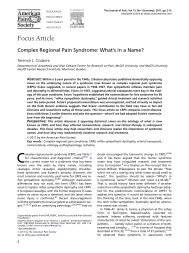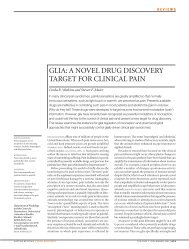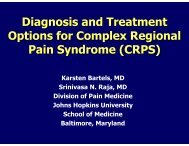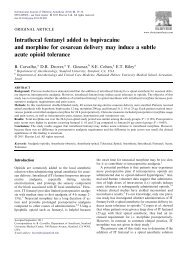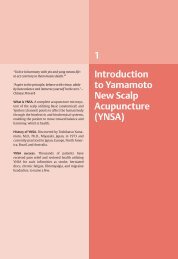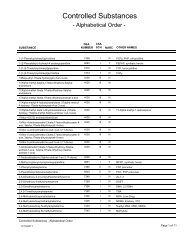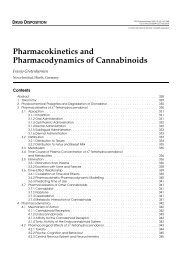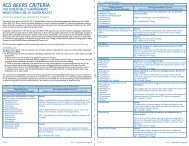1) Vitamin D For Chronic Pain - Pain Treatment Topics.org
1) Vitamin D For Chronic Pain - Pain Treatment Topics.org
1) Vitamin D For Chronic Pain - Pain Treatment Topics.org
Create successful ePaper yourself
Turn your PDF publications into a flip-book with our unique Google optimized e-Paper software.
<strong>Vitamin</strong> D for <strong>Chronic</strong> <strong>Pain</strong><br />
more critical factor. Taking 10,000 IU of D 3 daily for six months<br />
has been implicated as toxic, 22,132 whereas Holick [2007] 14 noted<br />
that this daily amount in adults can be well tolerated for five<br />
months. And, this 10,000 IU/day dose was used successfully and<br />
safely during three months in one study for relieving back pain. 74<br />
Vieth et al 100 demonstrated that 4000 IU of D 3 per day was well<br />
tolerated during 15 months of therapy. Concentrations of<br />
25(OH)D were increased to more optimal levels and parathyroid<br />
hormone was reduced, while calcium levels remained normal.<br />
Some researchers have proposed that long-term daily<br />
consumption of 40,000 IU of vitamin D would be needed to<br />
cause hypercalcemia. 18,19 The US Office of Dietary Supplements<br />
133 notes that hypercalcemia can result from 50,000 IU/day<br />
or more taken for an extended period of time.<br />
There have not been any reports in the literature of a single,<br />
one-time excessive dose of vitamin D (D 2 or D 3 ) being toxic or<br />
fatal in humans. However, a number of incident reports of<br />
vitamin D toxicity involving very high doses, and including 6<br />
fatalities, have appeared in the literature. In the incident<br />
reports, encompassing 77 cases of toxicity, amounts of vitamin<br />
D taken for periods ranging from days to years included daily<br />
doses from 160,000 IU up to an astounding 2.6 million<br />
IU. 125,126,128,129,130,131,134,135 The relatively few fatalities resulted from<br />
secondary causes during treatment for hypercalcemia. A<br />
common feature of all incidents was that victims were not<br />
knowingly or intentionally taking excessive amounts of vitamin<br />
D, and no one was taking vitamin D under practitioner supervision.<br />
In almost all cases, toxic overdoses could have been<br />
avoided with better quality control in product manufacture<br />
and/or education of patients in the proper use of supplements.<br />
As another measure of safety, consolidated data for 2006 were<br />
examined (the most recently reported year) from 61 poison<br />
control centers serving 300 million persons in the United<br />
States. 136 There were only 516 mentions of incidents involving<br />
vitamin D which, by comparison, were roughly one-fourth the<br />
number for vitamin C and merely 0.8% of all incidents involving<br />
vitamin products. Only 13% of all vitamin D cases required<br />
treatment in a healthcare facility, although adverse<br />
signs/symptoms were absent or minimal in almost all patients<br />
(92%). Only 5 of the victims had more pronounced<br />
signs/symptoms of vitamin D toxicity, but these were not life<br />
threatening and there were no serious adverse events reported.<br />
<strong>Vitamin</strong> D-Drug Interactions<br />
There have been relatively few mentions in the literature of<br />
vitamin D supplements interacting with other agents or medications,<br />
and these are summarized in Table 7. In most cases, the<br />
potency of vitamin D is reduced by the other drug and the<br />
vitamin dose can be increased to accommodate this. Conversely,<br />
very high doses of vitamin D should be avoided due to possible<br />
risks of hypercalcemia when taken with digitalis/digoxin or<br />
certain diuretics.<br />
Additionally, St. John’s wort, 27 excessive alcohol, 133 and tobacco<br />
smoking 138 have been reported to potentially reduce the effects<br />
of vitamin D. Mineral oil and stimulant laxatives decrease<br />
dietary calcium absorption and can influence hypocalcemia. 133<br />
Gastric bypass and other gastric or intestinal resection procedures<br />
have been associated with vitamin D insufficiency. 60,106<br />
It should be noted that not all patients would be affected by<br />
these interactions or effects, and vitamin D has not been noted<br />
TABLE 6. Signs/Symptoms of D Toxicity<br />
(Hypercalcemia)<br />
• abdominal pain<br />
• achy muscles/joints<br />
• anorexia<br />
• azotemia<br />
• calcifications<br />
• constipation<br />
• disorientation/confusion<br />
• fatigue/lethargy<br />
• fever/chills<br />
• GI upset<br />
• hypertension<br />
• muscle weakness<br />
• nausea<br />
• nervousness<br />
• polyuria<br />
• proteinuria<br />
• pruritus<br />
• excessive thirst<br />
• urinary casts<br />
• vomiting<br />
• weight loss<br />
References: Barrueto et al 125 ; Blank et al 126 ; Calcitriol 12 ; Carroll and<br />
Schade 127 ; Ergocalciferol 13 ; Johnson 20 ; Klontz and Acheson 128 ; Koutkia et<br />
al 129 ; Todd et al 130 ; Vieth et al 131<br />
to interfere harmfully with the actions of any medications.<br />
Therefore, none of the reported interactions or effects has been<br />
indicated in the literature as a contraindication for vitamin D<br />
supplementation.<br />
Conclusions<br />
Extensive clinical evidence and expert commentary supports the<br />
opinion that recommending adequate vitamin D intake for<br />
helping patients with chronic musculoskeletal pain and fatigue<br />
syndromes should be more widely recognized and acted upon.<br />
In many cases, contributing factors are nonspecific or undetermined.<br />
Even in cases where a specific etiology has been<br />
diagnosed, the potential for vitamin D deficit as a factor<br />
contributing to and/or prolonging the pain condition should<br />
not be ruled out.<br />
Further clinical research studies would be helpful. <strong>Vitamin</strong> D<br />
is not proposed as a “cure” for all chronic pain conditions or in<br />
all patients. Optimal clinical outcomes of vitamin D therapy<br />
might be best attained via multicomponent treatment plans<br />
addressing many facets of health and pain relief. Therefore,<br />
vitamin D is not suggested as a replacement for any other<br />
approaches to pain management.<br />
To start, a conservative total daily supplementation of 2400<br />
IU to 2800 IU of vitamin D 3 is proposed as potentially benefitting<br />
patients. Along with that, some patience is advised regarding<br />
expectations for improvements; it may require up to 9<br />
months before maximum effects are realized. In some cases,<br />
other factors or undetected conditions may be contributing to<br />
a chronic pain condition that vitamin D supplementation alone<br />
cannot ameliorate.<br />
In sum, for patients with chronic musculoskeletal pain and<br />
related symptoms, supplemental vitamin D has a highly favorable<br />
benefit to cost ratio, with minimal, if any, risks. In all likelihood,<br />
it would do no harm and probably could do much good.■<br />
Acknowledgments<br />
The author wishes to acknowledge and thank the following<br />
expert reviewers of the full research report for their helpful<br />
comments and assistance: Bruce Hollis, PhD; Michael F. Holick,<br />
MD, PhD; Seth I. Kaufman, MD; Lee A. Kral, PharmD, BCPS;<br />
Paul W. Lofholm, PharmD, FACA; N. Lee Smith, MD; James D.<br />
Toombs, MD; Winnie Dawson, RN, BSN, MA.<br />
Practical PAIN MANAGEMENT, July/August 2008<br />
©2008 PPM Communications, Inc. Reprinted with permission.<br />
39



